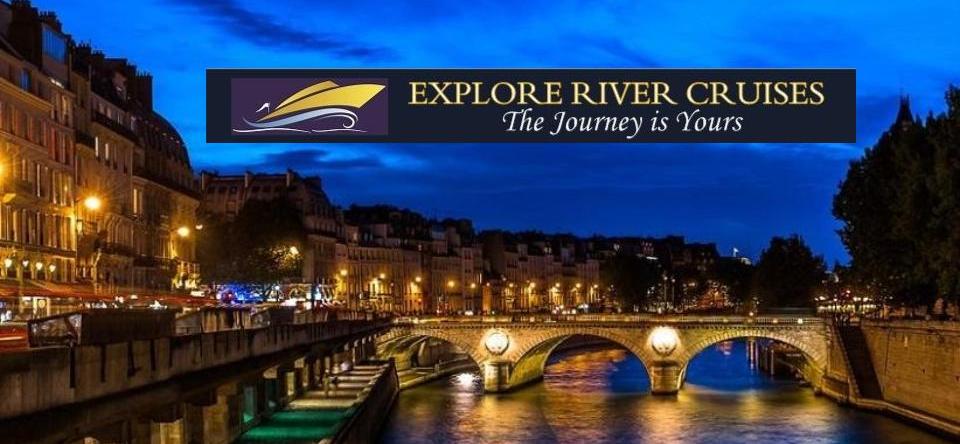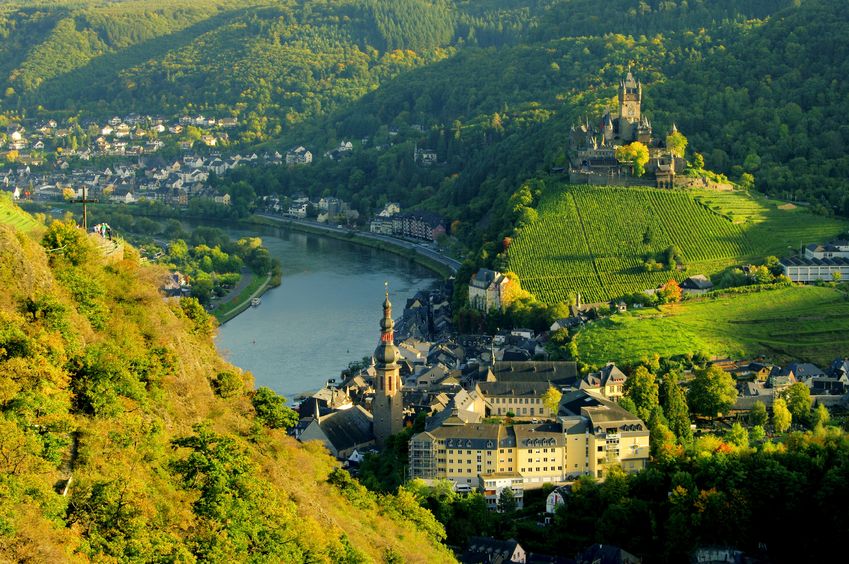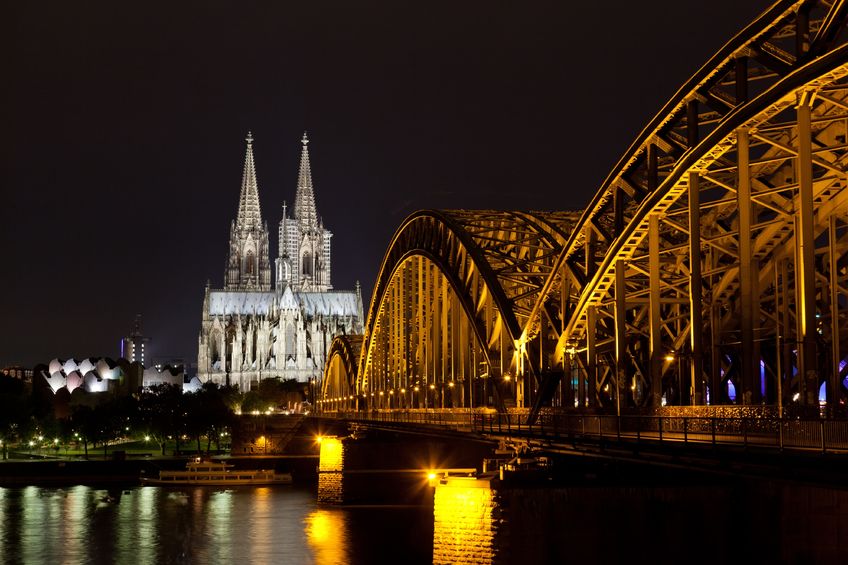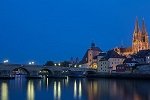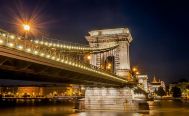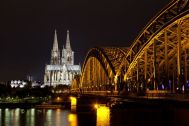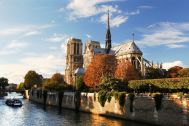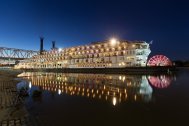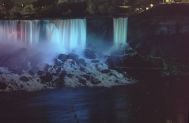8 UNESCO Sites for River Cruises in Germany
You probably aren’t thinking about UNESCO World Heritage Sites if you’re planning to take a river cruise. Interestingly though, you’ll find that each destination for Germany river cruises offers shore excursions that are focused on cultural and historical sites. Many of the places you’ll visit will feature UNESCO Sites. Germany is rich with them!

Middle Rhine Valley nearby Oberwesel
By Holger Weinandt (Own work) [CC-BY-SA-3.0-de (http://creativecommons.org/licenses/by-sa/3.0/de/deed.en)], via Wikimedia Commons
So, what does it take for a place, monument, or natural landform to be designated as a UNESCO World Heritage Site? The criteria can be found here, but a brief explanation is given below.
“It must have outstanding universal value and must meet at least one out of 10 selection criteria. The first 6 are based on cultural criteria, and the last 4 are based on natural criteria”.
A river cruise in Germany that features UNESCO sites will take place on one river or some combination of these four rivers: Moselle River, Rhine River, Main River and Danube River. The 8 UNESCO World Heritage Sites featured are described in this article.
#1 Roman Monuments

Cathedral of St. Peter in Trier, Germany
River: Moselle
This UNESCO World Heritage site consists for a group of structures that were built in Trier, Germany. The city is located on the banks of the Moselle River in western Germany near Luxembourg.
Trier has preserved more Roman monuments than any other city in Germany. Some of them are listed below.
The Cathedral of St. Peter
This is the oldest cathedral in Germany. The Cathedral of St. Peter is also referred to as the Trier Cathedral. Its construction began in 326 A.D. under Constantine’s rulership and continued through the 12th century.
The cathedral that was originally built was 4x larger than the cathedral today. Much of it had to be reconstructed due to damage it sustained in the 5th an 9th centuries. It’s still the largest church structure in Trier.
Different architectural styles were used in the Cathedral’s design reflecting trends from a few eras. The center of the main chapel was made with Roman brick and is part the building today. In 1035 Romanesque-style architecture was added to the structure followed by Gothic and Baroque styles until its completion.
The cathedral that was originally built was 4x larger than the cathedral today. Much of it had to be reconstructed due to damage it sustained in the 5th an 9th centuries. It’s still the largest church structure in Trier.
Church of Our Lady in Trier
The church is also called Liebfruenkirche, which means Church of Our Dear Lady in German. It was built next to St. Peter’s Cathedral in the 13th century. The building was constructed in a French-Gothic style and is the oldest Gothic church in Germany.
Basilica of Constantine
Built in 310, this huge brick structure was the throne hall of Constantine and other Roman emperors. In the 5th century the building was destroyed by German forces.
The Basilica was restored in the 17th century and used as living quarters until its renovation in the 19th century. The structure is now used as a Protestant church.
Imperial Baths of Trier
The Imperial Baths were built in the 4th century during Constantine’s reign in Trier. Considered to be the largest Roman baths outside of Rome, they are some of the best-preserved ancient Roman ruins in Germany.
Trier Roman Amphitheatre
Another well-preserved structure, the Trier Roman Amphitheatre dates back to the 1st century. It once held up to 20,000 spectators and still hosts open air events – one of the few Roman ruins that is used in Germany today.
Porta Nigra
The name “Porta Nigra” means Black Gate. It was one of four Roman gates that was built to protect the city of Trier from intruders. The Porta Nigra is the only surviving Roman gate in Trier.
A hermit monk by the name of Simeon lived in Porta Nigra for seven years until his death in 1035. After his death, the Church of St. Simeon was built around the gate; but Napoleon's army destroyed it in 1803. Porta Nigra's Romanesque structure survived, and the Roman Gate was restored as closely as it could be to its original construction.
Roman Monuments: Added to UNESCO World Heritage list in 1986.
Criteria: 4 cultural
Video of Roman Monuments
#2 Upper Middle Rhine Valley

Town of Bacharach, Germany Overlooking the Rhine River
The Upper Middle Rhine Valley or the Rhine Gorge is about 40 miles long located in Germany on the Rhine River. It stretches from Koblenz just past Rudesheim on the east bank and ends in Bingen on the west bank.
The Moselle River flows in a northwesterly direction and joins the Rhine River in Koblenz. Along the Rhine Gorge, the Moselle River is lined with beautiful landscape, castles, vineyards and historic towns.
One of the most famous areas of the Upper Middle Rhine Valley is the Lorelei Rock, which is located on the east bank of the river near St. Goarshausen, Germany.
The hills along the Rhine Gorge are lined with several magnificent castles. Some of these include:
Marksburg Castle – located above the town of Braubach, Germany. It was built in 1117 and is the only medieval castle of the Rhine that has never been destroyed.
Burg Pfalzgrafenstein Castle – built on a small piece of land in the middle of the Rhine River called Pfalz Island. It’s located near Kaub, Germany.
Burg Rheinfels Castle – the largest castle overlooking the Rhine. Much of it was badly damaged and most of its structure is considered a castle ruin. Today a luxury hotel and a museum are housed in the outer part of the structure.
Stolzenfels Castle – located in Koblenz, Germany. The castle was originally built in the13th century. In 1689 it was destroyed by the French Army, and remained as castle ruins until it was rebuilt in the 19th century.
Upper Middle Rhine Valley: Added to UNESCO World Heritage list
in 2002
Criteria: 3 cultural
Video of Upper Middle Rhine Valley
#3 Cologne Cathedral
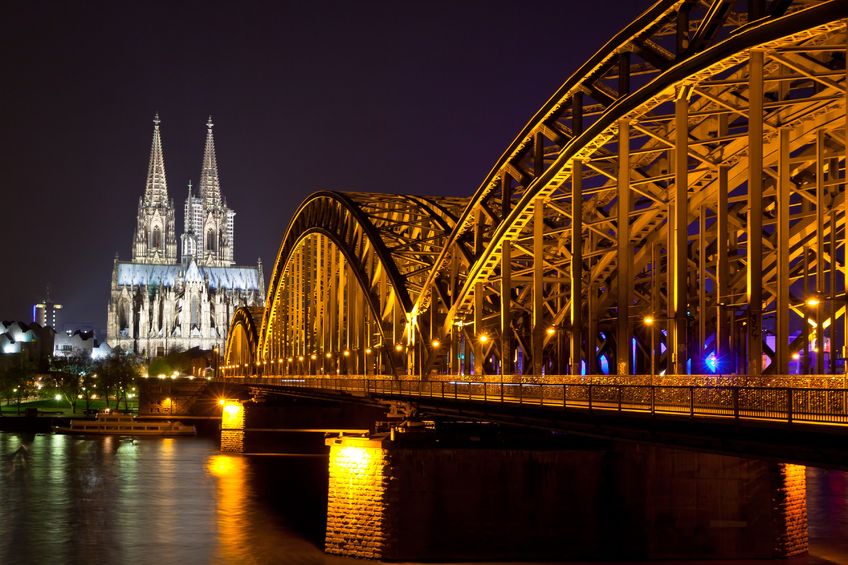
Cologne Cathedral and Hohenzollern Bridge from the Rhine River
River: Rhine
The Cologne Cathedral is a beautiful and magnificent structure. According to Wikipedia, it’s Germany’s most visited landmark receiving about 20,000 visitors per day.
The cathedral was built over a 640-year time period – from 1248 to1880. Its construction represents true Gothic cathedral architecture. Some of the Cologne Cathedral’s features in addition to its size are the stained glass windows, a 322-foot spiral staircase with 509 steps that overlooks the Rhine River, and two 515-feet towers.
Until 1884 Cologne Cathedral was the tallest church in the world. The exterior surface of the building covers about 23,000 square feet, which makes it the largest of any church in the world.
A few of the art treasures that are found inside the cathedral are: the Ottonian Gero Cross; the Shrine of the Three Kings; an outstanding example of Rhenish goldwork; the altarpiece of the patron saints of Cologne.
Cologne Cathedral: Added to UNESCO World Heritage list in 1996.
Criteria: 3 cultural
Video about the history of the Cologne Cathedral.
#4 Speyer Cathedral

Speyer Cathedral Along the Banks of the Rhine River
River: Rhine
The Speyer Cathedral is the largest Romanesque structure in the world and is the most famous landmark in Speyer, Germany.
The Romanesque-style architecture, which emerged in the 10th century, was very popular during the time construction of the cathedral began in 1030. It continued through 1106, and no other additions or significant changes were made to the structure again until the early 17th century.
Speyer Cathedral has three remaining chapels of its eight original chapels. There is a double chapel on the south side of the cathedral, which was a popular design in the 11th century. The 1st chapel is St. Emmeram and the 2nd chapel is St. Catherine.
The 3rd chapel, Saint Afra, is on the north side of the cathedral. In the original structure, there were five more chapels on the north side. They did not survive destruction in 1689 that took place during the Nine Years’ War.
Restoration of Speyer Cathedral was done during the middle of the 18th century and again beginning in 1957.
A few other interesting features include the chime, which has 9 bells. It’s located in the western dome of the building. On the east side of the cathedral, there is the Heidenturmchen or Heath Tower and a section of the wall that still stands. It was a fortification for the city of Speyer during medieval times.
Speyer Cathedral: Added to UNESCO World Heritage list in 1981.
Criteria: 1 cultural
Video of Speyer Cathedral
#5 Castles of Augustusburg and Falkenlust

Castle of Augustusburg in Bruhl, Germany
River: Rhine
The Augustusburg and Falkenlust Palaces are located in Bruhl, Germany about 5 miles west of the Rhine River. The city of Bruhl is in the northern Rhine region of Germany between Bonn and Cologne.
Both castles were built with Rococo-style architecture, which was popular in the 18th century. It’s an extension of Baroque-style architecture with lighter and less dramatic features than true Baroque-style.
Spacious gardens and parks connect the two properties that are just over a mile apart. The Augustusburg and Falkenlust Castles are open for tours, and the site also holds many concerts and cultural events throughout the year.
The Augustusburg Castle is the larger of the two structures. Originally built in 1298, Augustusburg Castle was destroyed in 1689 during the Nine Years’ War. It was rebuilt in 1728, and construction of the Falkenlust Castle began the following year in 1729. The Falkenlust is was completed in 1740.
Castles of Augustusburg and Falkenlust: Added to UNESCO World Heritage list in 1984.
Criteria: 2 cultural
Video of Castles of Augustusburg and Falkenlust
#6 Wurzburg Residence With the Court Gardens and Residence Square

Wurzburg Residence Near the Main River in Wurzburg, Germany
River: Main
Wurzburg Residence is a palace that was built in the 18th century. It’s located in Wurzburg, which is between the cities of Frankfurt and Nuremberg, Germany.
The palace is arranged around several and has baroque-style architecture – similar to many other castles built during this era. With its 400 rooms, Wurzburg Residence measures at about 318 ft. x 548 ft. Some of its more prominent rooms, include the Grand Salon, White Hall, Imperial Hall, Southern and Northern Apartments, Court Chapel and Court Gardens.
The staircase is also an impressive feature of the castle. It spans an area of 318 ft. x 548 ft. overlooking a vault that is beautifully decorated by paintings of the four continents of Asia, Europe, America and Africa. They are hand-painted scenes by artist, Giovanni Battista Tiopelo.
Wurzburg Residence has been going through restoration since 1945 after receiving significant damage to its structure during World War II.
Wurzburg Residence: Added to UNESCO World Heritage list in 1981.
Criteria: 2 cultural
Video of Wurzburg Residence
#7 Town of Bamberg
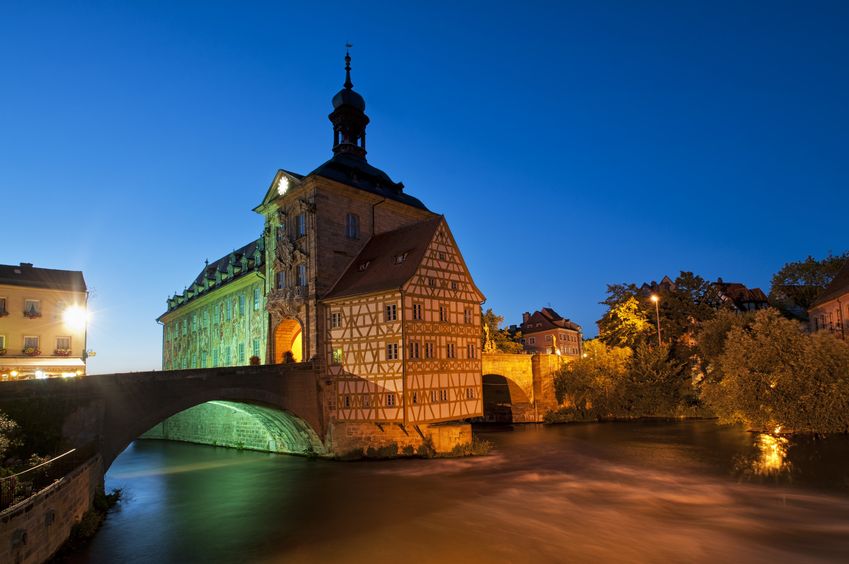
Old Town Hall of Bamberg
River: Main
Bamberg is a city in Bavaria, Germany. It’s located about 60 miles east of Wurzburg near the confluence of the Main River and the Regnitz River. Another important waterway located close by is the Main-Danube Canal, which connects the Rhine, Main and Danube Rivers.
The Town Bamberg is well-known for its "Seven Hills". It is built on top of these Seven Hills: 1) Cathedral; 2) Michaelsberg; 3) Obere Pfarre; 4) Stefansberg; 5) Jakobsberg; 6) Altenburger; and 7) Abtsberg. Some of the city’s main sights are listed below.
Bamberg Cathedral was originally built in the early 11th century. After being partially destroyed by fire in 1081, a new structure was built in the 12th century. The Bamberg Cathedral had Romanesque-style architecture added to it during the 13th century. Prominent features of the cathedral are its four grand towers and also the many historic pieces of art it houses.
Old Town Hall was built in 1386 in the middle of the Regnitz River, which is accessible by two bridges.
Michaelsberg Abbey built in the 12th century on one of Bamberg’s “Seven Hills” is a former Benedictine monastery and is now used as a home for senior citizens.
Alte Hofhaltung was a residence for bishops in the 16th and 17th centuries, and the Neue Residenz was their residence after the 17th centuries.
Altenburg Castle – a former residence of the bishops between the 13th and 16th centuries. The castle was destroyed in 1553 and was not restored until a doctor bought the property in 1801. Today the Altenberg is a high-class restaurant that serves many visitors as well as locals of Bamberg.
The Town of Bamberg escaped most of the destruction other German cities faced during war time, which helped it keep many of its authentic architectural structures in tact.
Town of Bamberg: Added to UNESCO World Heritage list in 1993.
Criteria: 2 cultural
Video of Town of Bamberg
#8 Old Town of Regensburg With Stadtamhof
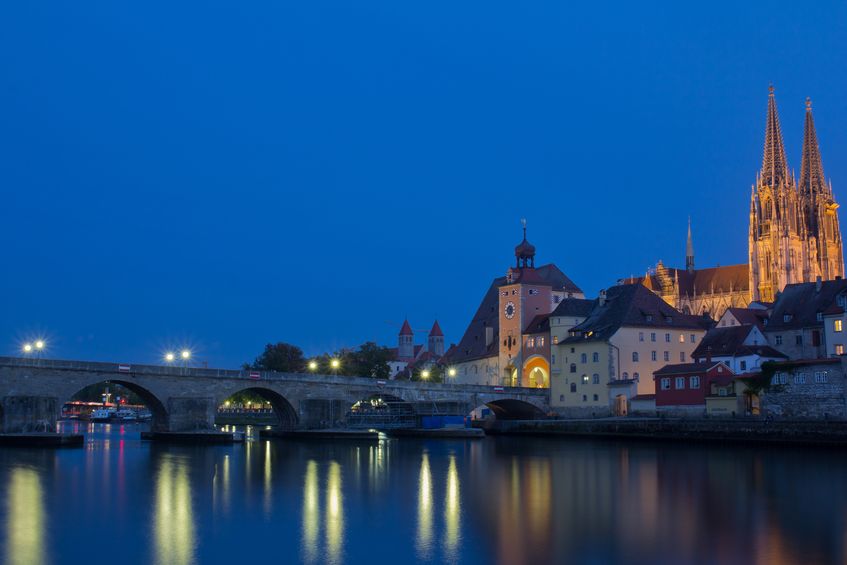
City of Regensburg, Germany at Night from the Danube River
River: Danube
Regensburg is a city in Bavaria, Germany between Nuremberg and Passau. Its located on the banks of the Danube River at the confluence of the Danube and Regen Rivers.
Regensburg is considered to be one of the best-preserved medieval cities. It did sustain some minimal damage during World War II; and during a war in the 19th century, some of the houses in the town were burned. The historic buildings that exist today were preserved, though. Some of the sites are listed below.
Steinerne Brücke, the Old Stone Bridge, is Regensburg’s historic Landmark. It was built from 1135-1146 and is the highlight of the Dom Cathedral. The bridge was built to serve as an international trade route between northern Europe, Venice, France and Novgorod, which was a medieval Russian state.
The Dom Cathedral is an example of pure German gothic architecture. It was constructed over a few centuries between 1275 and 1634. The towers were completed in the 19th century.
Church of St. James or the Schottenkirche is a Romanesque basilica of the 12th century.
The Old Town Hall or Altstadt Hall dates back to the 14th century. From 1663 to 1806 it was occupied by the Imperial Diet.
St. Emmerman’s Abbey was converted into a castle in 1809 for the prince. Today it is still owned by the Thurns and Taxis’ family. The property was originally the church of Obermunster and the abbey church of St. Emmeram. The Thurns and Taxis’ Palace has two museums, which are open for privately-guided tours. The Coach House Museum is owned by the family, and the Thurns and Taxis’ Museum is owned by the Bavarian State Museum.
Old Town of Regensburg: Added to UNESCO World Heritage List in 2006
Criteria: 3 cultural
Video of Old Town of Regensburg
If you enjoyed this article, please share it with other people you think would also enjoy reading it. Thank you! :)

Lauri Wakefield is a travel writer who specializes in river cruises in Europe and the U.S. Connect with her on Twitter and Google+.
You Might Also Like:
